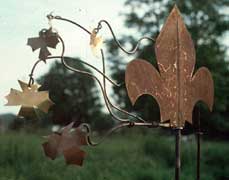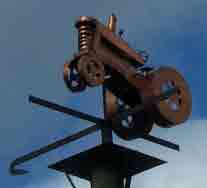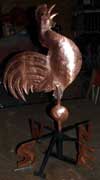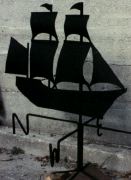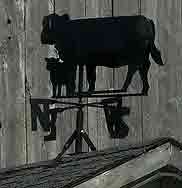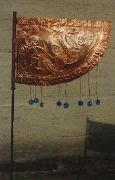Point to the Wind!
Weather Vanes
Artisan Blacksmith Darrell Markewitz of the The Wareham Forge
has long been fasinated by the motion of objects influanced by the wind. Weather
vanes, be they historic reproductions or modern sculptural creations have always
been a favorite to build. The strength of hand forged steel is combined by the
three dimenstional forms possible through the use of solid copper, brass, aluminum
and stainless steel sheets
Originally the Wareham Forge produced a standard set of of 'production line'
weathervanes. Each of these was based on a historic Canadian design from the
19th century, selected from those in various museum collections - and an 1860's
hardware catalogue. Each is a bold cut out, about 12 x 18", and made of heavy
weight galvanised steel (18 ga. - 1/32' thick) or solid copper and brass sheet,
for a lifetime of service.
Custom designs, of any size, have always been created. Past work has included
many for farms, with such designs as honey bee, bull - even a scale model of
an Twin Heuy helicopter! An important consideration is working to the correct
scale, often commercial pieces that look fine in hand shrink to obscurity when
mounted up on your roof.
Latest Revisions Added January 2011
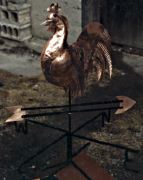 |
Weather Vanes
"What's the weather?" Perhaps one of the most commonly heard topics
of conversation between Canadians. In the days before radio forecasts,
every farmer knew that the direction of the wind was a sure sign of
what was to come...
Continue bellow for past work
|
Sculptural 'Windbiles'
Pure artistic creations, driven by the wind. A new line of metal sculptures,
featuring the fluid lines of hand forged steel - given motion.
Now given a separate section - go HERE
|
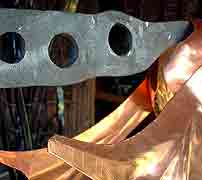 |
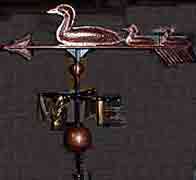
|
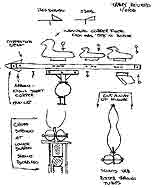
|
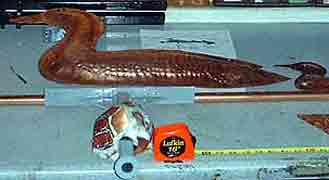 |
Finshed in the Workshop |
Original Design Layout |
Closeup of Copper Figures |
'Loon Family' /
Tahy House - Spring 2006
This project involved the creation of a large weathervane to be mounted on
a structure roughly 25 feet at the peak, on top of which sat a decorative cupola.
The size of the vane needed to be quite large to reflect this viewing distance.
The main spar was almost six feet long, formed in the shape of an arrow that
supports a group of three Loons made of copper, one larger and two smaller.
There is a set of directional indicators with brass letters below this. These
are bracketed by a pair of sheet copper balls. The whole had to be designed
to break down into smaller pieces to allow for shipping to the customer's home
in New York State.
The design of the individual figures was supplied by the customer. Each is composed
of two individual pieces of 20 GA solid copper sheet. These were lightly dished
to create a simple 3D profile, about 2 inches thick. Each surface is punch worked
with chisels to add details to the figures. The large loon is about 24 inches
long by 8 inches tall (in proportion). The two smaller loons are about 12 inches
long by 4 inches tall. The two halves were joined with solid copper rivets.The
finished figures are secured to the main spar by a number of 3/16” dia.
stainless steel bolts / nuts / washers. There is also an arrow feather, consisting
of a single piece of copper sheet. It has a surface also punch worked, and will
be similarly attached.
Bellow the main spar, which pivioted on a steel ball bearing, were mounted
two copper spheres. In the middle section of the vane was fitted a pair of bars
bearing N/S/E/W directional letters. The directional letters were cut from 20
GA solid brass sheet with individual letters are about 8 by 8 inches.
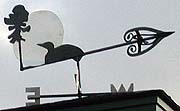
|
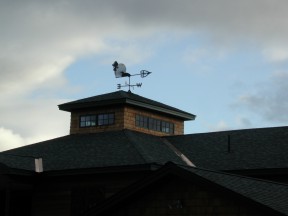
|
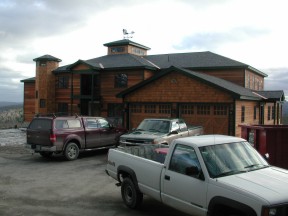
|
| On the Coppula |
Seen from the Ground |
'Moonlit Loon' /
Hersey House - December 2004
Hersey House is located in Maine USA. The customer approached me a about creating
a large weather vane, based on his design. After some consultation, these images
show what I created for the house. The main figure consists of a Tom Thompson
styled pine tree and a loon, backed by a full moon. The moon shape is cut from
satin finish stainless steel, the other figures from heavy galvenized steel
sheet that has been painted black. The vane is finished with a decorative arrow
created from forged elments. The mount has directional points again formed from
heavy sheet.
One of the challenging aspects of this project was designing around the limitations
of shipping. The vane figures and arrow bolts to the long main spar. The roof
mount was a large and complex shape. To reduce the volume required, a lenght
of 5/8 dia threaded rod was used for the upright - that could be removed during
shipping. The two bars that make the compass points fitted down onto this upright
and when interlocked could be bolted to place. (This allowed to accurately aim
the compass!) The whole weather vane packed down to three packages - large,
within the limits of postal services.
I have included the other two images here to illustrate another point. When
designing any weather vane, its appearance from the ground must be considered.
The second image shows the vane is comfortable visually when compared to the
coppula it was mounted on. The third image is taken from the middle of the house
yard. Notice how much smaller the vane looks. 'Moonlit Loon' is actually
over six feet long and the figures two feet high. This proved to be the
size limit imposed by the shipping requirements. The directional letters, themselves
about 8 inches tall, are now just visible. The lesson is that anyone ordering
a weather vane must consider how it is going to look on the roof - not when
sitting on the ground in front of you.
Thanks to E. Hersey for the images.
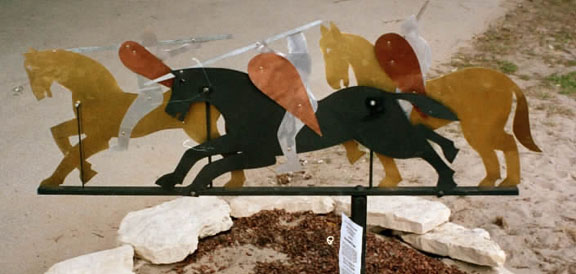
| "A Kingdom with his Horse"
This piece was created specifically for the exhibition 'Reflections
of the Conquest' mounted by An Droichead at the Woodstock Museum in
February of 2002. The design was directly taken from the groupings of
mounted Normans seen in several places along the Bayeux Tapestry. Considering
the 'cartoon like' outlines of the embroidery, I decided to stick with
simple outlines - rather than detail and texture the metal sheet. The
use of copper, brass and painted steel echoes the dominant colours from
the original tapestry. It now is mounted (at ground level) in a private
home just outside Kitchener. |
Older Commissions and Art Weathervanes
| |
|
"Winter of our Discontent" This is one of my very few political commentary pieces. Around the time of the PQ managing somehow to become the 'Official Opposition'.
I was asked to submit a piece for a summer long outdoor garden styled gallery exhibit. The individual Maple leaves of brass and copper fit losely on forged loops. In the wind they would shift and quiver randomly.
I intentionly left the heavy steel sheet forming the Fleur'd'Lys unpainted, allowing it to rust with time.
The fate of this piece is unknown, perhaps that itself being a further relivation on the theme? |
"Tractor"
The more unusual projects are always the most interesting. This was escencially a scale model of a specific antique tractor - which the owner collected. Creating the cutting templates were a
challenge, then fitting all the individual pieces together. A shaft runs up an off centred tube with the bearing, allowing the whole body to swivel. Again, the aspect of scale comes into play. The figure here is over 24 inches long (photo taken from ground level, then cropped). |
|
|
"Weathercock - 2010"
This is another redition from one of my favourite Quebec historic vanes
(see also right). This version uses a single piece of 20 gage copper sheet
to form the body. It is lightly dished to provide both strength and a
better wind catching surface. The 'ball' is formed from two shallow dished
pieces of copper soldered together Wide copper compass points and an adjustable
roof mount finish the piece. The body of the rooster is about 18 inches
tall, and is mounted outside Orangeville. |
"Copper Rooster"
This vane, 'Copper Rooster' (6/92), is also on a private home, this one
in Mount Forest. It is a full 3-D rendering of a rooster, based on an
artifact from Quebec of the 1870's. The individual pieces are dished and
surface punched, then assembled with both rivets and solder. The body
pivots to face the wind, and has inset glass eyes. The rooster alone is
about 18 inches high. |
| |
|
"Ship at Sail"
The first of two 'cut out' pieces (5/95) is now on a house in the Peterborough
area. It was designed for mounting on a two story house, and so is rather
large. (About 2 x 3 feet - people do tend to forget how objects seem
to shrink when mounted high up!) It is made of heavy galvanised steel,
with the sails individual pieces, sculpted into curves.
"Cow and Calf"
This is another simple sheet steel cut out weather vane. Again the size
is fairly large (about two feel long). It graces a farm near Chestley
in SW Ontario. One of the special aspects of this piece is that it duplicates
a favourite photograph of the owner's prizewinning cow and her calf. |
"Norse Weather Board"
This is one of a series of four matching pieces made in 1992. The shape
is based on a number of artifacts from the Viking Age, circa 1000 AD.
Originally these 'weather boards' would in fact be fixed to the prow of
a longship. Weighted ribbons would hang down, measuring not only wind
direction, but relative speed as well. Each of the four I made was of
similar size, formed of heavy sheet copper. The patterns on each differed,
with designs based on the four points of the compass, this is the one
representing West. Each had a central figure: North - eagle, South - hart,
East - Loki, West - serpent. The type was in Norse runes, with the sailor's
prayer "Sun at back and fair winds" along the top. The line along the
bottom edge related to the particular direction. In this case the runes
give brief sailing directions from Iceland to Vinland. |
return to the Gallery

(Short Cut HERE back to the site index / map.)
Text and photography © 1998 - 2011,
Darrell Markewitz









